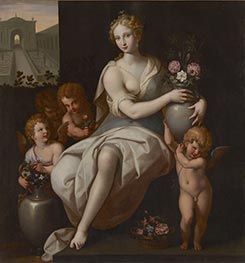Ambroise Dubois Painting Reproductions 1 of 1
c.1542–c.1614
French Mannerist Painter
Ambroise Dubois is one of those artists who might slip under the radar, but whose contributions reveal an intriguing cross-pollination between Flemish tradition and French courtly grandeur. Born in Antwerp between 1542 and 1570, Dubois found his way to France and became a pivotal figure in the second School of Fontainebleau, a movement defined by its blend of Italian Mannerism and French elegance. The artistic influences he absorbed - particularly from Niccolò dell'Abbate and Francesco Primaticcio - would shape his career as a painter of portraits and mythological scenes, a genre that held a particular fascination for the courts of Europe.
By 1606, Dubois had secured the role of painter to Marie de Médicis, a position that placed him squarely in the heart of French political and artistic power. His work for the queen, most notably the decoration of her Cabinet at Fontainebleau, showcases a delicate balance of courtly opulence and narrative depth. His choice of subject - scenes from "Tancred and Clorinda", inspired by Torquato Tasso's "Gerusalemme Liberata" - speaks to the period’s taste for the mythological and heroic, yet Dubois’s handling of these stories is marked by a distinct sensitivity. His figures seem less concerned with grandeur and more invested in the human experience within these larger-than-life tales.
While his mythological scenes demonstrate a dramatic flair, Dubois’s true strength lies in his portraiture. These were not just exercises in courtly flattery but genuine attempts to capture the essence of his sitters. His portraits reflect a tension between idealization and realism, offering a more intimate glimpse into the lives of his subjects. There’s a quiet dignity to these works, and while they may lack the showy embellishments seen in other royal portraits, they resonate with a subtlety that feels deeply personal.
Dubois died in Fontainebleau, between 1614 and 1619, having left a body of work that weaves together the intellectual and emotional concerns of his time. Although his name doesn’t carry the weight of some of his contemporaries, his role as a bridge between the Flemish and French traditions is undeniable. His legacy is that of an artist who navigated the complexities of myth and portraiture with a deft hand, bringing a northern sensibility to the grand narratives of the French court. For those willing to look closer, Ambroise Dubois offers a fascinating window into an era where the boundaries between national traditions and artistic schools were constantly shifting.
By 1606, Dubois had secured the role of painter to Marie de Médicis, a position that placed him squarely in the heart of French political and artistic power. His work for the queen, most notably the decoration of her Cabinet at Fontainebleau, showcases a delicate balance of courtly opulence and narrative depth. His choice of subject - scenes from "Tancred and Clorinda", inspired by Torquato Tasso's "Gerusalemme Liberata" - speaks to the period’s taste for the mythological and heroic, yet Dubois’s handling of these stories is marked by a distinct sensitivity. His figures seem less concerned with grandeur and more invested in the human experience within these larger-than-life tales.
While his mythological scenes demonstrate a dramatic flair, Dubois’s true strength lies in his portraiture. These were not just exercises in courtly flattery but genuine attempts to capture the essence of his sitters. His portraits reflect a tension between idealization and realism, offering a more intimate glimpse into the lives of his subjects. There’s a quiet dignity to these works, and while they may lack the showy embellishments seen in other royal portraits, they resonate with a subtlety that feels deeply personal.
Dubois died in Fontainebleau, between 1614 and 1619, having left a body of work that weaves together the intellectual and emotional concerns of his time. Although his name doesn’t carry the weight of some of his contemporaries, his role as a bridge between the Flemish and French traditions is undeniable. His legacy is that of an artist who navigated the complexities of myth and portraiture with a deft hand, bringing a northern sensibility to the grand narratives of the French court. For those willing to look closer, Ambroise Dubois offers a fascinating window into an era where the boundaries between national traditions and artistic schools were constantly shifting.
1 Ambroise Dubois Paintings

Flora n.d.
Oil Painting
$3090
$3090
Canvas Print
$71.24
$71.24
SKU: DIS-19012
Ambroise Dubois
Original Size: 148 x 137 cm
Fuji Art Museum, Tokyo, Japan
Ambroise Dubois
Original Size: 148 x 137 cm
Fuji Art Museum, Tokyo, Japan